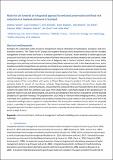Files in this item
Water for all : towards an integrated approach to wetland conservation and flood risk reduction in a lowland catchment in Scotland
Item metadata
| dc.contributor.author | Vinten, Andrew | |
| dc.contributor.author | Kuhfuss, Laure | |
| dc.contributor.author | Shortall, Orla | |
| dc.contributor.author | Stockan, Jenni | |
| dc.contributor.author | Ibiyemi, Adekunle | |
| dc.contributor.author | Pohle, Ina | |
| dc.contributor.author | Gabriel, Marjorie | |
| dc.contributor.author | Gunn, Iain | |
| dc.contributor.author | May, Linda | |
| dc.date.accessioned | 2020-07-02T23:36:21Z | |
| dc.date.available | 2020-07-02T23:36:21Z | |
| dc.date.issued | 2019-09-15 | |
| dc.identifier | 259539627 | |
| dc.identifier | 3847e53c-5f8c-4c4a-a663-24d16a1e5b13 | |
| dc.identifier | 85067874161 | |
| dc.identifier.citation | Vinten , A , Kuhfuss , L , Shortall , O , Stockan , J , Ibiyemi , A , Pohle , I , Gabriel , M , Gunn , I & May , L 2019 , ' Water for all : towards an integrated approach to wetland conservation and flood risk reduction in a lowland catchment in Scotland ' , Journal of Environmental Management , vol. 246 , pp. 881-896 . https://doi.org/10.1016/j.jenvman.2019.05.135 | en |
| dc.identifier.issn | 0301-4797 | |
| dc.identifier.uri | https://hdl.handle.net/10023/20202 | |
| dc.description | Authors thanks Rural & Environment Science & Analytical Services Division of the Scottish Government (SEFARI) project number S100015-00 for funding this work. | en |
| dc.description.abstract | Strategies for sustainable water resources management require integration of hydrological, ecological and socio-economic concerns. The “Water for all” project has sought to develop a multi-disciplinary science case for innovative management of water levels and flows in a lowland catchment in Scotland. Water demands of arable agriculture, protection from flood risk and conservation needs of lowland mesotrophic wetlands needed to be considered. Water management strategy focused on the outlet zone of Balgavies lake in Eastern Scotland, where the Lunan Water discharges into a partially confined common channel (lade). Water releases to a mill, to the downstream river, and to floodplain wetlands (Chapel Mires) are partially controlled by an existing weir. Based on observations of management of this weir, we postulated that upgrading hydraulic management in this zone could reduce upstream flood risk, help protect mesotrophic wetlands and facilitate downstream water supply at low flows. We considered potential for: (a) installing a remotely operated tilting weir, for improved management of release and routing of flows from the common lade; (b) dredging of the common lade in combination or instead of the tilting weir. Rapid ecological assessment and mixing analysis of the Lunan Water with waters in Chapel Mires showed a gradient of trophic status across the wetlands linked to impact of river-borne nutrients. Stage-discharge relationships, derived from steady-state approximations of the in-channel hydraulics, showed that the proposed tilting weir had potential to divert seasonal nutrient rich water from the upstream Lake away from Chapel Mires. Significant impact of the proposed weir on upstream flood risk was not demonstrated, but carrying out dredging of the channel reduced the current observed probability of upstream flooding. The proposed weir could help to maintain these dredging benefits. Survey and interviews with catchment stakeholders and residents showed constructive interest in the scheme, with half of the respondents willing to pay to support its implementation. The survey also revealed concerns about the proposed project, especially its long-term governance. The lessons learned have wider relevance to development of an integrated approach to water ecosystem services provision, especially where benefits are uncertain and thinly spread across a range of users. | |
| dc.format.extent | 16 | |
| dc.format.extent | 1702636 | |
| dc.language.iso | eng | |
| dc.relation.ispartof | Journal of Environmental Management | en |
| dc.subject | Catchment management | en |
| dc.subject | Eco-hydrology | en |
| dc.subject | Hydraulic modelling | en |
| dc.subject | Nutrient enrichment | en |
| dc.subject | Socio-economic assessment | en |
| dc.subject | G Geography (General) | en |
| dc.subject | HD28 Management. Industrial Management | en |
| dc.subject | Environmental Engineering | en |
| dc.subject | Waste Management and Disposal | en |
| dc.subject | Management, Monitoring, Policy and Law | en |
| dc.subject | NDAS | en |
| dc.subject.lcc | G1 | en |
| dc.subject.lcc | HD28 | en |
| dc.title | Water for all : towards an integrated approach to wetland conservation and flood risk reduction in a lowland catchment in Scotland | en |
| dc.type | Journal article | en |
| dc.contributor.institution | University of St Andrews. School of Geography & Sustainable Development | en |
| dc.identifier.doi | https://doi.org/10.1016/j.jenvman.2019.05.135 | |
| dc.description.status | Peer reviewed | en |
| dc.date.embargoedUntil | 2020-07-03 |
This item appears in the following Collection(s)
Items in the St Andrews Research Repository are protected by copyright, with all rights reserved, unless otherwise indicated.

